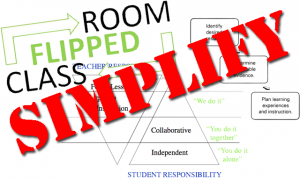 I like things simple. Break things down for me into their simplest terms and let’s talk.
I like things simple. Break things down for me into their simplest terms and let’s talk.
This is the model I follow when I talk to anyone about technology I try to break things down to their simplest parts as I would when I was planning lessons for when I taught in my third grade class years ago.
By thinking about things within the lens of explaining something to a 3rd grader, I force myself to focus on key concepts and ideas. This is not to imply that I talk down to people or dumb down the issues; rather I try to understand the point or lesson I intend to teach and get those points across clearly and with as little confusion or frustration as possible.
Simplicity is something that I think is sorely missing when from professional development in education.
Attend any conference — or take a look at any conference program — and you will see sessions offered on the Flipped Classroom, Close Reading, Backward Design or whatever the flavor of the month (or the hot book is on ASCD) happens to be.
Recently I attended the Educon 2.5 conference at the Science Leadership Academy and sat in on an excellent session on “Close Reading” with Christopher Lehman (@iChrisLehman – ChristopherLehman.com) & Kate Roberts (@TeachKate) from Teachers College Reading and Writing Project at Columbia University. I had no idea what close reading looked like these days and was intrigued by the description:
“With 24-hour news cycles and the constant presence of screens, text rushes past us at an astonishing rate. We must slow down, read closely, and uncover subtle messages in texts. This conversation focuses on studying, collaboratively with students, close reading skills and their transfer into media, culture, and daily life.”
Reading this I thought I was going to hear a conversation that related to media literacies and how to parse information from all of the different sources coming at each of us — teachers and students alike — on a daily basis.
What I learned was how to “carefully and purposefully” read a text to take it apart and “annotate, look for patterns and ask questions” about those “patterns” by using the “lens of word choice and evidence”. [Using close reading strategies I pulled out these words:screens, rushes, subtle, media, culture, life – proof I was engaged and paying attention]
But wait… isn’t “Close Reading” really just talking about comprehension?!?!?
I asked that very question and the answer was yes (though nuanced to focus on a short piece of text).
So why not just say you are going to talk about new or improved comprehension strategies? Why call is something different, something that might confuse someone or make him/her think it is going to be something drastically different from something with which he.she has already spent time?
For the past number of years professional development has focused on things like Backward Design, the Gradual Release of Responsibility model and curriculum mapping. Each of these concepts have some really great ideas and methods for helping to focus instruction, but there are often rules and forms that must be followed in order to do these things “right”.
As an example, in Backwards Design you need to fill in a template for your lesson where you identify key pieces. The form includes three steps, with seven sub-steps and a seven letter acronym to learn in order to complete one of the sub-steps, outlined below:
- Stage One – Desired Results
- Established Goal(s) – Relevant goals design will address
- Understandings – “big ideas”
- Essential Questions – provocative questions that will foster inquiry.
- What students will know – key knowledge or what student will be able to do
- Stage Two – Assessment Evidence
- Performance tasks – what are the tasks and how will they be judged
- Other evidence – quizzes, tests to demonstrate achievement and how student will self-assess
- Stage 3 – Learning Plan
- Learning Activities
- W – where students are coming from (prior knowledge)
- H the hook to hold interest
- E – equip students, experiences and explore issues
- R – rethink and revise understanding of work
- E – evaluate work and implications
- T – tailored to need, interests & abilities of learner
- O – organized to maintain initial & sustained engagement
- Learning Activities
Isn’t backward design really about starting with your end goal and setting up experiences within the classroom to reach that goal? Aren’t these steps just part of good teaching and learning?
Yes!
Does a teachers who are expected to have mastery of their own content or subject area need to master all of these steps to improve instruction within their own classes? Do they need to know what box to put what piece of their lesson, assessment or experience into in order to improve teaching and learning? Don’t they just need to understand the “big ideas” of Backwards Design?
For those of us involved in planning and structuring professional development offerings for our faculty, we need to be mindful of what our institutional goals are and the type of school we want to be. Many of the trends or models of instruction offer great ideas for improving teaching and learning, and coordinators of professional development should certainly understand the ins-and-outs of these models.
Those folks need to have a deeper understanding of the best models and be able to break them down to their simplest forms for faculty to understand and implement in their own teaching. By simplifying things for our faculties, we will empower teachers by virtue of the fact that they won’t feel like they are constantly being asked to unlearn what was the hot trend last year and relearn all the new jargon for the new one.
Lets talk about the big ideas/concepts of these various methods and ground them in what we already know as educators. Let’s talk about assessmeant and collaboration. Let’s talk about planning a good lesson, assessment or experience that will motivate and inspire students to learn. If jargon is to be used, it should be jargon that flows through all of the trends to keep confusion to a minimum and bring simplicity to the forefront.


